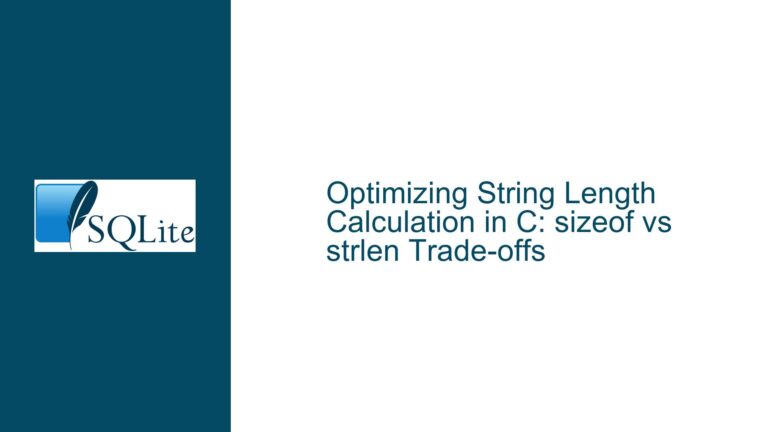Redundant Automatic Index Creation in SQLite Queries
Issue Overview: Redundant Automatic Index Creation in Recursive Queries and CTEs
SQLite is a powerful, lightweight database engine that often creates automatic indices to optimize query performance. However, in certain scenarios, particularly with recursive queries and Common Table Expressions (CTEs), SQLite may create redundant automatic indices. This redundancy occurs when the same index is created multiple times within a single query execution, or when indices with overlapping columns are created sequentially without reusing existing ones. This behavior can lead to unnecessary computational overhead, increased memory consumption, and suboptimal query performance.
The issue is particularly evident in queries involving recursive CTEs, where SQLite creates automatic indices during both the setup and recursive steps of the query. For example, an index on a table like internal(src, dst) might be created twice: once during the initial setup and again during the recursive step. Similarly, in top-level CTEs, SQLite may create multiple automatic indices on the same table with progressively added columns, such as fake(vertex), fake(vertex, family), and fake(vertex, family, is_push, is_pop, is_stack), instead of reusing the most comprehensive index.
This behavior is not immediately apparent in the EXPLAIN QUERY PLAN output, as it omits index creation steps. However, it can be observed using debugging tools like .log /dev/stderr in the SQLite shell, which logs automatic index creation events. The redundancy in index creation can significantly impact query performance, especially in large datasets or complex queries where memory and computational resources are at a premium.
Possible Causes: Why SQLite Creates Redundant Automatic Indices
The creation of redundant automatic indices in SQLite can be attributed to several factors, including the query structure, the optimizer’s decision-making process, and the limitations of automatic index management. Below are the primary causes of this issue:
Query Structure and Scope of Automatic Indices
Automatic indices in SQLite are created on-the-fly to optimize specific parts of a query. However, these indices are often scoped to the immediate subquery or CTE in which they are created. For example, in a recursive CTE, the automatic index created during the setup phase is not reused in the recursive step because the optimizer treats these as separate scopes. This leads to the creation of identical indices multiple times within the same query.Optimizer’s Lack of Index Reuse Awareness
SQLite’s query optimizer does not always recognize that an existing automatic index can be reused for subsequent operations. For instance, if an index onfake(vertex, family, is_push, is_pop, is_stack)is created, the optimizer may still create additional indices onfake(vertex)andfake(vertex, family)because it does not fully evaluate whether the broader index can satisfy the narrower requirements.Progressive Index Creation in CTEs
In queries involving CTEs, SQLite may create automatic indices with progressively added columns as the query execution progresses. This occurs because the optimizer creates indices based on the immediate needs of each query step, without considering whether a previously created index with additional columns could fulfill the same purpose. For example, an index onfake(vertex)might be created first, followed byfake(vertex, family), and finallyfake(vertex, family, is_push, is_pop, is_stack), even though the last index could have been used from the beginning.Memory and Performance Trade-offs
SQLite’s automatic index creation is designed to balance query performance with memory usage. In some cases, the optimizer may prioritize creating new indices over reusing existing ones to avoid potential memory overhead or to simplify query execution. This trade-off can lead to redundant index creation, especially in complex queries with multiple subqueries or recursive steps.Limitations of Automatic Index Management
Automatic indices in SQLite are temporary and exist only for the duration of the query. This transient nature limits the optimizer’s ability to manage and reuse indices effectively across different parts of a query. Additionally, automatic indices are not persisted in the database schema, which means they cannot be referenced or reused in subsequent queries.
Troubleshooting Steps, Solutions & Fixes: Addressing Redundant Automatic Index Creation
To address the issue of redundant automatic index creation in SQLite, developers can employ a combination of query optimization techniques, schema design improvements, and manual index management. Below are detailed steps and solutions to mitigate this problem:
Analyze Query Plans and Logs
The first step in troubleshooting redundant automatic index creation is to analyze the query plan and logs. Use theEXPLAIN QUERY PLANstatement to understand how SQLite is executing the query. Additionally, enable logging using.log /dev/stderrin the SQLite shell to capture automatic index creation events. This will help identify where and why redundant indices are being created.Refactor Queries to Minimize Index Creation
Refactor queries to reduce the need for automatic indices. For example, in recursive CTEs, consider restructuring the query to minimize the number of subqueries or recursive steps that require separate indices. Use explicit joins or subqueries instead of relying on automatic indices to optimize performance.Create Manual Indices for Critical Columns
Where possible, create manual indices on columns that are frequently used in queries. Manual indices are persisted in the database schema and can be reused across multiple queries, reducing the need for automatic indices. For example, iffake(vertex, family, is_push, is_pop, is_stack)is a commonly used index, create it manually using theCREATE INDEXstatement.Use Covering Indices
Covering indices include all the columns required by a query, eliminating the need for additional indices. For example, instead of creating separate indices onfake(vertex)andfake(vertex, family), create a single covering index onfake(vertex, family, is_push, is_pop, is_stack). This ensures that the query can use the same index for different operations.Optimize CTEs and Recursive Queries
In recursive queries and CTEs, optimize the query structure to reuse existing indices. For example, in a recursive CTE, ensure that the setup and recursive steps use the same index by explicitly referencing it. This may require rewriting the query to align the index usage across different parts of the query.Monitor and Control Memory Usage
Redundant automatic index creation can increase memory usage, especially in large datasets. Monitor memory consumption using SQLite’s built-in tools and adjust thecache_sizeandpage_sizesettings to optimize performance. Additionally, consider using thePRAGMA temp_storedirective to store temporary indices in memory or on disk, depending on the available resources.Leverage Query Hints and Pragmas
Use SQLite’s query hints and pragmas to influence the optimizer’s behavior. For example, thePRAGMA automatic_indexdirective can be used to disable automatic index creation entirely, forcing the optimizer to rely on manual indices. This can be useful in scenarios where automatic indices are causing performance issues.Profile and Benchmark Queries
Use profiling tools like the federprof profiler mentioned in the discussion to measure the impact of redundant automatic indices on query performance. Benchmark different query structures and index configurations to identify the most efficient approach. This empirical analysis can help fine-tune queries and indices for optimal performance.Consider Alternative Database Engines
While SQLite is a versatile database engine, it may not always be the best choice for complex queries with high performance requirements. Consider using alternative lightweight databases like DuckDB or H2, which offer advanced indexing and optimization features. Evaluate the trade-offs between SQLite and these alternatives based on the specific use case.Engage with the SQLite Community
If the issue persists, engage with the SQLite community for additional insights and solutions. Share query plans, logs, and profiling data on forums or mailing lists to get feedback from other developers and SQLite experts. The community may provide alternative approaches or workarounds that are not immediately apparent.
By following these troubleshooting steps and solutions, developers can effectively address the issue of redundant automatic index creation in SQLite, improving query performance and resource utilization.






